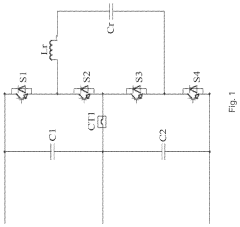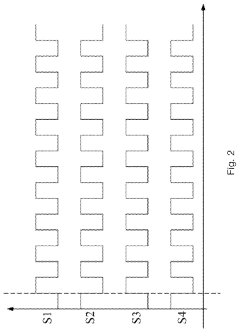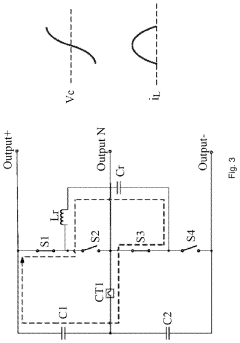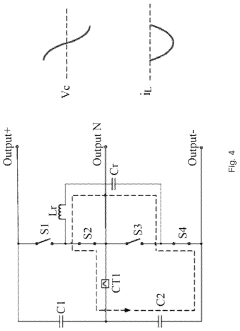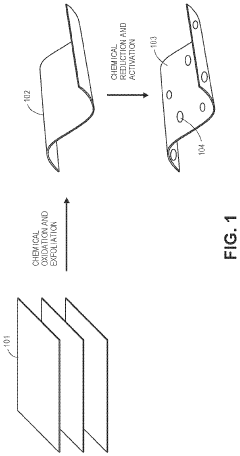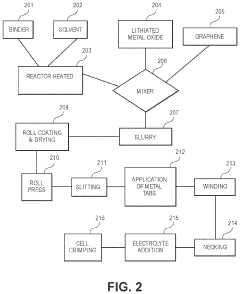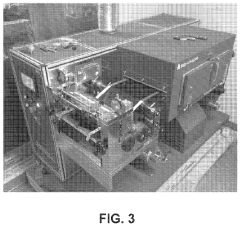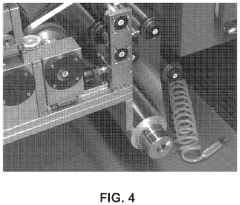Blade Battery's Role in Developing Nations' Energy Strategies
AUG 7, 20259 MIN READ
Generate Your Research Report Instantly with AI Agent
Patsnap Eureka helps you evaluate technical feasibility & market potential.
Blade Battery Overview and Objectives
The Blade Battery, developed by BYD, represents a significant advancement in lithium-ion battery technology, particularly in the context of developing nations' energy strategies. This innovative battery design aims to address key challenges in energy storage, safety, and sustainability, which are crucial factors for emerging economies seeking to modernize their energy infrastructure.
At its core, the Blade Battery is a lithium iron phosphate (LFP) battery with a unique structural design that enhances its safety profile and energy density. The battery cells are arranged in a blade-like configuration, allowing for more efficient space utilization and improved heat dissipation. This design not only increases the battery's overall capacity but also significantly reduces the risk of thermal runaway, a critical safety concern in battery technology.
The primary objective of the Blade Battery in developing nations is to provide a reliable, safe, and cost-effective energy storage solution. These countries often face challenges such as unreliable power grids, limited access to electricity in rural areas, and the need for clean energy alternatives to fossil fuels. The Blade Battery's characteristics make it particularly well-suited to address these issues.
One of the key goals is to support the integration of renewable energy sources into developing nations' power grids. The Blade Battery's high energy density and long cycle life make it an ideal candidate for large-scale energy storage systems that can balance the intermittent nature of solar and wind power. This capability is crucial for countries looking to increase their renewable energy capacity while maintaining grid stability.
Another objective is to enhance energy access in remote and off-grid areas. The Blade Battery's safety features and durability make it suitable for deployment in harsh environments where maintenance and replacement can be challenging. This could potentially revolutionize rural electrification efforts, providing reliable power to communities that have long been underserved.
Furthermore, the Blade Battery aims to accelerate the adoption of electric vehicles (EVs) in developing nations. Its improved safety, longer range, and faster charging capabilities address many of the concerns that have hindered EV adoption in these markets. By enabling more affordable and practical electric transportation options, the Blade Battery could play a significant role in reducing urban air pollution and dependence on imported fossil fuels.
In the broader context of national energy strategies, the Blade Battery technology aligns with the goals of energy independence, sustainability, and economic development. By fostering local production and technological expertise in advanced battery systems, developing nations can reduce their reliance on imported energy technologies and create new opportunities for industrial growth and job creation.
At its core, the Blade Battery is a lithium iron phosphate (LFP) battery with a unique structural design that enhances its safety profile and energy density. The battery cells are arranged in a blade-like configuration, allowing for more efficient space utilization and improved heat dissipation. This design not only increases the battery's overall capacity but also significantly reduces the risk of thermal runaway, a critical safety concern in battery technology.
The primary objective of the Blade Battery in developing nations is to provide a reliable, safe, and cost-effective energy storage solution. These countries often face challenges such as unreliable power grids, limited access to electricity in rural areas, and the need for clean energy alternatives to fossil fuels. The Blade Battery's characteristics make it particularly well-suited to address these issues.
One of the key goals is to support the integration of renewable energy sources into developing nations' power grids. The Blade Battery's high energy density and long cycle life make it an ideal candidate for large-scale energy storage systems that can balance the intermittent nature of solar and wind power. This capability is crucial for countries looking to increase their renewable energy capacity while maintaining grid stability.
Another objective is to enhance energy access in remote and off-grid areas. The Blade Battery's safety features and durability make it suitable for deployment in harsh environments where maintenance and replacement can be challenging. This could potentially revolutionize rural electrification efforts, providing reliable power to communities that have long been underserved.
Furthermore, the Blade Battery aims to accelerate the adoption of electric vehicles (EVs) in developing nations. Its improved safety, longer range, and faster charging capabilities address many of the concerns that have hindered EV adoption in these markets. By enabling more affordable and practical electric transportation options, the Blade Battery could play a significant role in reducing urban air pollution and dependence on imported fossil fuels.
In the broader context of national energy strategies, the Blade Battery technology aligns with the goals of energy independence, sustainability, and economic development. By fostering local production and technological expertise in advanced battery systems, developing nations can reduce their reliance on imported energy technologies and create new opportunities for industrial growth and job creation.
Market Demand Analysis in Developing Nations
The market demand for Blade Batteries in developing nations is driven by several key factors, primarily the growing need for reliable and affordable energy storage solutions. As these countries strive to improve their energy infrastructure and increase access to electricity, there is a significant opportunity for advanced battery technologies like the Blade Battery to play a crucial role.
Developing nations often face challenges with their power grids, including frequent outages and limited coverage in rural areas. This creates a strong demand for energy storage systems that can provide backup power and support off-grid solutions. The Blade Battery's high energy density and long cycle life make it particularly well-suited for these applications, offering a more cost-effective and durable alternative to traditional lead-acid batteries.
The rapid growth of renewable energy projects in developing countries also contributes to the increasing demand for advanced battery technologies. As these nations invest in solar and wind power to reduce their reliance on fossil fuels and meet climate goals, the need for efficient energy storage solutions becomes paramount. The Blade Battery's ability to store large amounts of energy and its improved safety features make it an attractive option for grid-scale storage projects and renewable energy integration.
Furthermore, the expanding electric vehicle (EV) market in developing nations presents another significant opportunity for Blade Battery adoption. As governments implement policies to promote cleaner transportation and reduce air pollution in urban areas, the demand for affordable and high-performance EVs is on the rise. The Blade Battery's enhanced safety, longer range, and faster charging capabilities position it as a compelling choice for EV manufacturers targeting these emerging markets.
The potential market size for Blade Batteries in developing nations is substantial. With over 800 million people still lacking access to electricity worldwide, mostly in developing regions, the market for off-grid and mini-grid solutions alone represents a significant opportunity. Additionally, the global energy storage market is projected to grow rapidly, with developing countries expected to account for an increasing share of this growth.
However, it is important to note that market penetration in developing nations may face challenges such as limited infrastructure, regulatory hurdles, and competition from established battery technologies. Overcoming these obstacles will require strategic partnerships, localized manufacturing, and tailored solutions that address the specific needs and constraints of each market.
In conclusion, the market demand for Blade Batteries in developing nations is driven by the need for reliable energy storage, the growth of renewable energy projects, and the expansion of the electric vehicle market. While challenges exist, the potential for widespread adoption and significant market growth is substantial, making it a promising technology for addressing the energy needs of developing countries.
Developing nations often face challenges with their power grids, including frequent outages and limited coverage in rural areas. This creates a strong demand for energy storage systems that can provide backup power and support off-grid solutions. The Blade Battery's high energy density and long cycle life make it particularly well-suited for these applications, offering a more cost-effective and durable alternative to traditional lead-acid batteries.
The rapid growth of renewable energy projects in developing countries also contributes to the increasing demand for advanced battery technologies. As these nations invest in solar and wind power to reduce their reliance on fossil fuels and meet climate goals, the need for efficient energy storage solutions becomes paramount. The Blade Battery's ability to store large amounts of energy and its improved safety features make it an attractive option for grid-scale storage projects and renewable energy integration.
Furthermore, the expanding electric vehicle (EV) market in developing nations presents another significant opportunity for Blade Battery adoption. As governments implement policies to promote cleaner transportation and reduce air pollution in urban areas, the demand for affordable and high-performance EVs is on the rise. The Blade Battery's enhanced safety, longer range, and faster charging capabilities position it as a compelling choice for EV manufacturers targeting these emerging markets.
The potential market size for Blade Batteries in developing nations is substantial. With over 800 million people still lacking access to electricity worldwide, mostly in developing regions, the market for off-grid and mini-grid solutions alone represents a significant opportunity. Additionally, the global energy storage market is projected to grow rapidly, with developing countries expected to account for an increasing share of this growth.
However, it is important to note that market penetration in developing nations may face challenges such as limited infrastructure, regulatory hurdles, and competition from established battery technologies. Overcoming these obstacles will require strategic partnerships, localized manufacturing, and tailored solutions that address the specific needs and constraints of each market.
In conclusion, the market demand for Blade Batteries in developing nations is driven by the need for reliable energy storage, the growth of renewable energy projects, and the expansion of the electric vehicle market. While challenges exist, the potential for widespread adoption and significant market growth is substantial, making it a promising technology for addressing the energy needs of developing countries.
Current State and Challenges of Energy Storage
Energy storage technologies have made significant strides in recent years, yet they still face numerous challenges, particularly in developing nations. The current state of energy storage is characterized by a mix of established and emerging technologies, each with its own set of advantages and limitations.
Lithium-ion batteries dominate the market, offering high energy density and relatively long lifespans. However, their widespread adoption in developing countries is hindered by high costs and concerns about raw material availability. Lead-acid batteries, while more affordable, suffer from shorter lifespans and lower energy density, limiting their effectiveness in large-scale applications.
Emerging technologies like flow batteries and sodium-ion batteries show promise for grid-scale storage but are still in early stages of commercialization. Mechanical storage systems such as pumped hydro and compressed air energy storage are mature technologies but face geographical constraints and high initial investment costs.
One of the primary challenges in developing nations is the lack of robust infrastructure to support advanced energy storage systems. Inadequate power grids, limited technical expertise, and insufficient regulatory frameworks pose significant obstacles to the widespread implementation of modern storage solutions.
Cost remains a critical barrier, with many advanced storage technologies still too expensive for large-scale deployment in resource-constrained environments. This is particularly true for lithium-ion batteries, where the high upfront costs can be prohibitive despite their superior performance characteristics.
Environmental concerns also present challenges, especially regarding the disposal and recycling of batteries. Developing nations often lack the necessary facilities and regulations to handle the end-of-life management of energy storage systems, potentially leading to environmental hazards.
The intermittent nature of renewable energy sources like solar and wind power amplifies the need for reliable and efficient energy storage solutions. However, matching storage capacity to variable renewable generation remains a complex technical challenge, particularly in regions with limited grid stability.
Scalability is another significant hurdle. As developing nations seek to expand their energy access and transition to cleaner sources, the ability to rapidly scale up storage capacity becomes crucial. This requires not only technological advancements but also improvements in manufacturing capabilities and supply chain management.
Climate resilience poses an additional challenge, as many developing nations are located in regions prone to extreme weather conditions. Energy storage systems must be designed to withstand these environmental stresses while maintaining performance and safety standards.
Addressing these challenges requires a multifaceted approach, combining technological innovation, policy support, and international cooperation. As technologies like the Blade Battery emerge, they offer potential solutions to some of these issues, particularly in terms of cost-effectiveness and safety. However, their successful integration into developing nations' energy strategies will depend on overcoming the broader systemic challenges facing the energy storage sector.
Lithium-ion batteries dominate the market, offering high energy density and relatively long lifespans. However, their widespread adoption in developing countries is hindered by high costs and concerns about raw material availability. Lead-acid batteries, while more affordable, suffer from shorter lifespans and lower energy density, limiting their effectiveness in large-scale applications.
Emerging technologies like flow batteries and sodium-ion batteries show promise for grid-scale storage but are still in early stages of commercialization. Mechanical storage systems such as pumped hydro and compressed air energy storage are mature technologies but face geographical constraints and high initial investment costs.
One of the primary challenges in developing nations is the lack of robust infrastructure to support advanced energy storage systems. Inadequate power grids, limited technical expertise, and insufficient regulatory frameworks pose significant obstacles to the widespread implementation of modern storage solutions.
Cost remains a critical barrier, with many advanced storage technologies still too expensive for large-scale deployment in resource-constrained environments. This is particularly true for lithium-ion batteries, where the high upfront costs can be prohibitive despite their superior performance characteristics.
Environmental concerns also present challenges, especially regarding the disposal and recycling of batteries. Developing nations often lack the necessary facilities and regulations to handle the end-of-life management of energy storage systems, potentially leading to environmental hazards.
The intermittent nature of renewable energy sources like solar and wind power amplifies the need for reliable and efficient energy storage solutions. However, matching storage capacity to variable renewable generation remains a complex technical challenge, particularly in regions with limited grid stability.
Scalability is another significant hurdle. As developing nations seek to expand their energy access and transition to cleaner sources, the ability to rapidly scale up storage capacity becomes crucial. This requires not only technological advancements but also improvements in manufacturing capabilities and supply chain management.
Climate resilience poses an additional challenge, as many developing nations are located in regions prone to extreme weather conditions. Energy storage systems must be designed to withstand these environmental stresses while maintaining performance and safety standards.
Addressing these challenges requires a multifaceted approach, combining technological innovation, policy support, and international cooperation. As technologies like the Blade Battery emerge, they offer potential solutions to some of these issues, particularly in terms of cost-effectiveness and safety. However, their successful integration into developing nations' energy strategies will depend on overcoming the broader systemic challenges facing the energy storage sector.
Existing Blade Battery Solutions
01 Blade battery structure and design
Blade batteries feature a unique structural design that optimizes space utilization and energy density. The thin, elongated shape allows for efficient packaging in electric vehicles, improving overall battery performance and range. This design also enhances heat dissipation and structural integrity, contributing to improved safety and longevity of the battery pack.- Blade battery structure and design: Blade batteries feature a unique structural design that optimizes space utilization and enhances energy density. The design typically involves a flat, elongated shape that allows for efficient stacking and integration into electric vehicle battery packs. This structure contributes to improved overall battery performance and vehicle range.
- Safety features of blade batteries: Blade batteries incorporate advanced safety features to mitigate risks associated with thermal runaway and other potential hazards. These may include improved thermal management systems, enhanced structural integrity, and the use of safer cathode materials. Such features contribute to increased stability and reliability in electric vehicle applications.
- Manufacturing processes for blade batteries: The production of blade batteries involves specialized manufacturing techniques to ensure precision and quality. This may include advanced cell stacking methods, automated assembly processes, and stringent quality control measures. These manufacturing innovations contribute to the consistent performance and reliability of blade batteries.
- Integration of blade batteries in electric vehicles: Blade batteries are designed for optimal integration into electric vehicle platforms. Their unique form factor allows for efficient packaging within the vehicle chassis, potentially increasing interior space and improving weight distribution. This integration may also involve specialized cooling systems and battery management technologies.
- Performance characteristics of blade batteries: Blade batteries offer several performance advantages, including high energy density, fast charging capabilities, and long cycle life. These characteristics are achieved through the use of advanced materials, optimized cell design, and efficient thermal management. The performance of blade batteries contributes to extended driving range and improved overall electric vehicle efficiency.
02 Safety features of blade batteries
Blade batteries incorporate advanced safety features to prevent thermal runaway and enhance overall battery safety. These may include improved thermal management systems, robust cell separators, and innovative electrode designs. The focus on safety helps mitigate risks associated with battery failures in electric vehicles.Expand Specific Solutions03 Manufacturing processes for blade batteries
The production of blade batteries involves specialized manufacturing techniques to ensure consistency and quality. This includes precision cutting of electrode materials, advanced assembly methods, and stringent quality control processes. These manufacturing innovations contribute to the high performance and reliability of blade batteries.Expand Specific Solutions04 Integration of blade batteries in electric vehicles
Blade batteries are designed for seamless integration into electric vehicle platforms. Their compact form factor allows for flexible placement within the vehicle chassis, potentially improving weight distribution and vehicle dynamics. This integration may also involve specialized cooling systems and battery management technologies tailored for blade battery configurations.Expand Specific Solutions05 Performance characteristics of blade batteries
Blade batteries offer several performance advantages, including high energy density, fast charging capabilities, and long cycle life. These characteristics are achieved through optimized cell chemistry, advanced electrode materials, and efficient battery management systems. The performance improvements contribute to extended driving range and reduced charging times for electric vehicles.Expand Specific Solutions
Key Players in Blade Battery Industry
The Blade Battery market is in a growth phase, with developing nations increasingly focusing on sustainable energy strategies. The global market size for advanced battery technologies is expanding rapidly, driven by the growing demand for electric vehicles and renewable energy storage solutions. The technology's maturity is progressing, with major players like Samsung Electronics, CATL, and LG Energy Solution leading innovation. Companies such as Svolt Energy Technology and Hefei Guoxuan High-Tech Power Energy are also making significant strides in blade battery development. The competitive landscape is intensifying as both established electronics giants and specialized battery manufacturers vie for market share in this promising sector.
Hefei Guoxuan High-Tech Power Energy Co., Ltd.
Technical Solution: Hefei Guoxuan, also known as Gotion High-Tech, has developed battery technologies well-suited for developing nations' energy strategies. Their focus on LFP (lithium iron phosphate) batteries aligns with the need for safe, cost-effective, and long-lasting energy storage solutions in emerging markets[1]. Gotion has made significant advancements in improving the energy density of LFP batteries, addressing one of the technology's main limitations[2]. The company's semi-solid-state battery technology offers a bridge between current lithium-ion and future solid-state batteries, providing enhanced safety and energy density[3]. Gotion has also developed fast-charging technologies that can achieve 80% charge in 15 minutes, which is particularly valuable for electric vehicle adoption in countries with developing charging infrastructure[4]. Their focus on automated production and vertical integration helps reduce costs, making their batteries more accessible to price-sensitive markets in developing nations.
Strengths: LFP technology offers safety and longevity suitable for developing markets. Advancements in energy density and fast-charging address key limitations. Cost-effective production methods enhance accessibility. Weaknesses: Despite improvements, energy density may still lag behind some high-nickel cathode technologies, potentially limiting application in high-performance sectors.
Svolt Energy Technology Co., Ltd.
Technical Solution: Svolt Energy Technology has developed innovative battery solutions that can significantly impact developing nations' energy strategies. Their cobalt-free NMX (Nickel Manganese) batteries offer a more sustainable and cost-effective alternative to traditional lithium-ion batteries, addressing concerns about cobalt sourcing and cost in developing nations[1]. Svolt's high-nickel cathode technology provides high energy density, suitable for electric vehicles in countries with limited charging infrastructure[2]. The company has also made strides in solid-state battery technology, which promises enhanced safety and energy density, crucial for both mobile and stationary applications in emerging markets[3]. Svolt's modular battery pack designs allow for flexible scaling, making them adaptable to various energy storage needs from small rural applications to large-scale grid support[4].
Strengths: Cobalt-free technology addresses ethical and cost concerns. High energy density suitable for EV applications in developing markets. Modular designs offer flexibility for various energy storage needs. Weaknesses: As a relatively newer player, Svolt may face challenges in establishing a strong presence in developing markets compared to more established competitors.
Core Innovations in Blade Battery Technology
Power storage apparatus
PatentPendingUS20240222984A1
Innovation
- A power storage apparatus with a resonant circuit and switch configuration, along with a control module that adjusts switching frequencies and duty ratios to balance voltage differences between modules, and includes a frequency control module to dynamically manage charging and discharging based on real-time data and temperature variations.
Devices comprising carbon-based material and fabrication thereof
PatentPendingUS20240162413A1
Innovation
- Development of carbon-based materials and fabrication processes for lithium-ion batteries that enhance their charge storage capacity and cycle life, allowing them to hold twice the charge, provide twice the power, and last twice as long compared to commercial batteries.
Policy Landscape for Energy Storage
The policy landscape for energy storage in developing nations is rapidly evolving as governments recognize the critical role of advanced battery technologies in their energy strategies. Blade Battery technology, with its enhanced safety features and improved energy density, is gaining attention as a potential game-changer in these markets.
Many developing countries are implementing supportive policies to encourage the adoption of energy storage solutions. These policies often include financial incentives, such as tax breaks or subsidies for battery manufacturers and consumers. For instance, some nations have introduced feed-in tariffs or net metering schemes that reward the integration of battery storage with renewable energy systems.
Regulatory frameworks are being updated to accommodate the unique characteristics of advanced battery technologies like the Blade Battery. This includes revising grid connection standards, safety regulations, and performance requirements. Some countries are also developing specific energy storage targets as part of their national energy plans, creating a clear market signal for technologies like the Blade Battery.
The policy landscape is increasingly focusing on local manufacturing and technology transfer. Governments are offering incentives for companies to establish production facilities within their borders, aiming to create jobs and develop domestic expertise in battery technology. This approach aligns well with the Blade Battery's potential for scalable manufacturing.
Environmental policies are also shaping the energy storage landscape. Many developing nations are setting ambitious renewable energy goals, which inherently require robust energy storage solutions. The Blade Battery's improved lifecycle and reduced environmental impact make it an attractive option in this context.
However, challenges remain in policy implementation. Many developing countries struggle with limited financial resources, technical expertise, and regulatory capacity. This can lead to inconsistent policy application or delays in creating comprehensive frameworks for energy storage technologies.
International cooperation is playing a crucial role in shaping energy storage policies in developing nations. Organizations like the World Bank and regional development banks are providing technical assistance and funding for policy development and implementation. This support often includes knowledge sharing on best practices for integrating technologies like the Blade Battery into national energy strategies.
Many developing countries are implementing supportive policies to encourage the adoption of energy storage solutions. These policies often include financial incentives, such as tax breaks or subsidies for battery manufacturers and consumers. For instance, some nations have introduced feed-in tariffs or net metering schemes that reward the integration of battery storage with renewable energy systems.
Regulatory frameworks are being updated to accommodate the unique characteristics of advanced battery technologies like the Blade Battery. This includes revising grid connection standards, safety regulations, and performance requirements. Some countries are also developing specific energy storage targets as part of their national energy plans, creating a clear market signal for technologies like the Blade Battery.
The policy landscape is increasingly focusing on local manufacturing and technology transfer. Governments are offering incentives for companies to establish production facilities within their borders, aiming to create jobs and develop domestic expertise in battery technology. This approach aligns well with the Blade Battery's potential for scalable manufacturing.
Environmental policies are also shaping the energy storage landscape. Many developing nations are setting ambitious renewable energy goals, which inherently require robust energy storage solutions. The Blade Battery's improved lifecycle and reduced environmental impact make it an attractive option in this context.
However, challenges remain in policy implementation. Many developing countries struggle with limited financial resources, technical expertise, and regulatory capacity. This can lead to inconsistent policy application or delays in creating comprehensive frameworks for energy storage technologies.
International cooperation is playing a crucial role in shaping energy storage policies in developing nations. Organizations like the World Bank and regional development banks are providing technical assistance and funding for policy development and implementation. This support often includes knowledge sharing on best practices for integrating technologies like the Blade Battery into national energy strategies.
Environmental Impact Assessment
The environmental impact assessment of Blade Batteries in developing nations' energy strategies reveals both positive and negative implications. On the positive side, Blade Batteries offer a significant reduction in carbon emissions compared to traditional energy storage solutions. Their high energy density and long cycle life contribute to a more efficient and sustainable energy infrastructure, potentially reducing the overall environmental footprint of power generation and distribution systems in developing countries.
Furthermore, Blade Batteries' improved safety features, such as enhanced thermal stability and reduced risk of thermal runaway, minimize the potential for environmental hazards associated with battery failures or accidents. This aspect is particularly crucial in regions where regulatory frameworks and safety protocols may be less stringent.
The use of Blade Batteries in renewable energy systems, such as solar and wind power installations, can facilitate the transition to cleaner energy sources in developing nations. By providing reliable and efficient energy storage, these batteries enable better integration of intermittent renewable energy into the grid, reducing reliance on fossil fuels and associated pollution.
However, the environmental impact assessment also highlights potential challenges. The production of Blade Batteries requires the extraction and processing of raw materials, which can have localized environmental impacts in mining regions. Developing nations must carefully consider the sourcing of these materials to ensure sustainable and ethical practices.
Additionally, the end-of-life management of Blade Batteries presents both opportunities and challenges. While these batteries have a longer lifespan than many alternatives, eventually they will require proper disposal or recycling. Developing nations may need to invest in infrastructure and regulations to handle battery waste effectively, preventing potential soil and water contamination.
The assessment also considers the broader ecological impact of increased electrification enabled by Blade Batteries. While this transition generally leads to reduced emissions, it may also result in increased energy consumption if not managed properly. Developing nations must implement comprehensive energy policies that promote efficiency alongside the adoption of advanced battery technologies.
In conclusion, the environmental impact assessment of Blade Batteries in developing nations' energy strategies reveals a complex picture. While offering significant environmental benefits through reduced emissions and support for renewable energy integration, careful consideration must be given to the entire lifecycle of these batteries, from production to disposal, to maximize their positive impact and mitigate potential environmental risks.
Furthermore, Blade Batteries' improved safety features, such as enhanced thermal stability and reduced risk of thermal runaway, minimize the potential for environmental hazards associated with battery failures or accidents. This aspect is particularly crucial in regions where regulatory frameworks and safety protocols may be less stringent.
The use of Blade Batteries in renewable energy systems, such as solar and wind power installations, can facilitate the transition to cleaner energy sources in developing nations. By providing reliable and efficient energy storage, these batteries enable better integration of intermittent renewable energy into the grid, reducing reliance on fossil fuels and associated pollution.
However, the environmental impact assessment also highlights potential challenges. The production of Blade Batteries requires the extraction and processing of raw materials, which can have localized environmental impacts in mining regions. Developing nations must carefully consider the sourcing of these materials to ensure sustainable and ethical practices.
Additionally, the end-of-life management of Blade Batteries presents both opportunities and challenges. While these batteries have a longer lifespan than many alternatives, eventually they will require proper disposal or recycling. Developing nations may need to invest in infrastructure and regulations to handle battery waste effectively, preventing potential soil and water contamination.
The assessment also considers the broader ecological impact of increased electrification enabled by Blade Batteries. While this transition generally leads to reduced emissions, it may also result in increased energy consumption if not managed properly. Developing nations must implement comprehensive energy policies that promote efficiency alongside the adoption of advanced battery technologies.
In conclusion, the environmental impact assessment of Blade Batteries in developing nations' energy strategies reveals a complex picture. While offering significant environmental benefits through reduced emissions and support for renewable energy integration, careful consideration must be given to the entire lifecycle of these batteries, from production to disposal, to maximize their positive impact and mitigate potential environmental risks.
Unlock deeper insights with Patsnap Eureka Quick Research — get a full tech report to explore trends and direct your research. Try now!
Generate Your Research Report Instantly with AI Agent
Supercharge your innovation with Patsnap Eureka AI Agent Platform!
